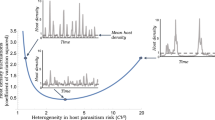Abstract
Phenomenological models represent a simplified approach to the study of complex systems such as host-parasitoid interactions. In this paper we compare the dynamics of three phenomenological models for host-parasitoid interactions developed by May (1978), May and Hassell (1981) and May et al. (1981). The essence of the paper by May and Hassell (1981) was to define a minimum number of parameters that would describe the interactions, avoiding the technical difficulties encountered when using models that involve many parameters, yet yielding a system of equations that could capture the essence of real world interactions in patchy environments. Those studies dealt primarily with equilibrium and coexistence phenomena. Here we study the dynamics through bifurcation analysis and phase portraits in a much wider range of parameter values, carrying the models beyond equilibrium states. We show that the dynamics can be either stable or chaotic depending on the location of a damping term in the equations. In the case of the stable system, when host density dependence acts first, a stable point is reached, followed by a closed invariant curve in phase space that first increases then decreases, finally returning to an asymptotically stable point. Chaos is not seen. On the other hand, when parasitoid attack occurs before host density dependence, chaos is inevitably apparent. We show, as did May et al. (1981) and stated earlier byWang and Gutierrez (1980), that the sequence of events in host-parasitoid interactions is crucial in determining their stability. In a chaotic state the size of the host (e.g., insect pests) population becomes unpredictable, frequently becoming quite large, a biologically undesirable outcome. From a mathematical point of view the system is of interest because it reveals how a strategically placed damping term can dramatically alter the outcome. Our study, reaching beyond equilibrium states, suggests a strategy for biological control different from that of May et al. (1981).
Similar content being viewed by others
References
Astrom, M., P. Lundberg and S. Lundberg (1996). Population dynamics with sequential density dependence. Oikos 75, 174–181.
Beddington, J. R., C. A. Free and J. H. Lawton (1975). Dynamic complexity in predator-prey models framed in difference equations. Nature 255, 58–60.
Chesson, P. L. and W. W. Murdoch, (1986). Aggregation of Risk: relationships among host-parasitoid models. Amer. Nat. 127, 696–715.
Getz, W. M. (1998). An introspection on the art of modeling in population ecology. Bio-Science 48, 540–552.
Godfray, H. C. J. and S. W. Pacala, (1992). Aggregation and the population dynamics of parasitoids and predators. Amer. Nat. 140, 30–40.
Hassell, M. P., R. M. May, S. W. Pacala and P. L. Chesson (1991). The persistence of host-parasitoid associations in patchy environments. I. A general criterion. Amer. Nat. 138, 568–583.
May, R. M. (1995). Necessity and chance: deterministic chaos in ecology and evolution. Bull. Am. Math. Soc. 32, 291–308.
May, R. M. (1978). Host-parasitoid systems in patchy environments: A phenomenological model. J. Animal Ecol. 47, 833–843.
May, R. M. and M. P. Hassell (1981). The dynamics of multiparasitoid-host interactions. Amer. Nat. 117, 234–261.
May, R. M., M. P. Hassell, R. M. Anderson and D. W. Tonkyn (1981). Density dependence in host-parasitoid models. J. Animal Ecol. 50, 855–865.
Mills, N. J. and W. M. Getz (1996). Modelling the biological control of insect pests: a review of host-parasitoid models. Ecol. Modelling 92, 121–143.
Murdoch, W. W. and A. Stewart-Oaten (1989). Aggregation by parasitoids and predators: effects on equilibrium and stability. Amer. Nat. 134, 288–310.
Perry, J. N (1987). Host-parasitoid models of intermediate complexity. Amer. Nat. 130, 955–957.
Perry, J. N. and L. R. Taylor (1986). Stability of real interacting populations in space and time: implications, alternatives and the negative binomial k. J. Animal Ecol. 55, 1053–1068.
Taylor, L. R., I. P. Woiwod and J. N. Perry (1979). The negative binomial as a dynamical model for aggregation, and the density dependence of k. J. Animal Ecol. 48, 289–304.
Wang, Y. H. and A. P. Gutierrez (1980). An assessment of the use of stability analyses in population ecology. J. Animal Ecol. 49, 435–452.
Author information
Authors and Affiliations
Rights and permissions
About this article
Cite this article
Cavalieri, L.F., Kocak, H. Comparative dynamics of three models for host-parasitoid interactions in a patchy environment. Bull. Math. Biol. 61, 141–155 (1999). https://doi.org/10.1006/bulm.1999.0083
Received:
Accepted:
Issue Date:
DOI: https://doi.org/10.1006/bulm.1999.0083




